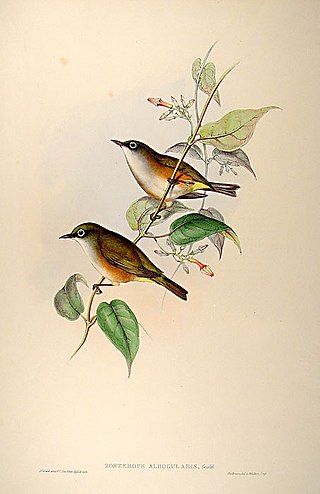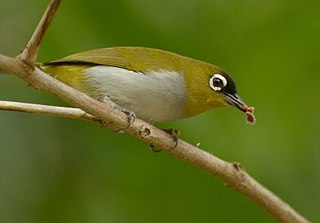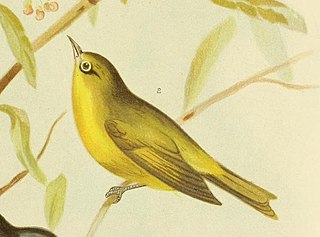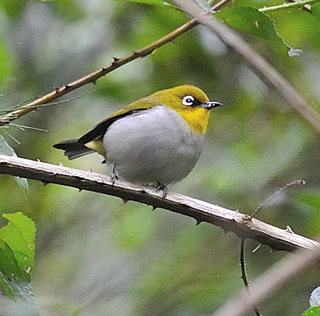
Zosterops is a genus of passerine birds containing the typical white-eyes in the white-eye family Zosteropidae. The genus has the largest number of species in the white-eye family. They occur in the Afrotropical, Indomalayan, and Australasian realms. Typical white-eyes have a length of between 8 and 15 cm. Their most characteristic feature is a conspicuous white feather ring around the eye, though some species lack it. The species in this group vary in the structural adaptations of the tongue. The Zosterops [griseotinctus] group is an example of a "great speciator" inhabiting a vast area and showing a remarkable morphological differentiation on islands, some of which maybe as close as 2 km (1.2 mi) apart.

The white-chested white-eye also known as white-breasted white-eye or Norfolk white-eye is a passerine from the family Zosteropidae. It is endemic to Norfolk Island between New Caledonia and New Zealand and it is regarded as either extremely rare or possibly extinct. Since 2000 the Australian government has considered the species extinct.

The Seychelles white-eye is a rare warbler-like perching bird from the family of white-eyes (Zosteropidae). It is endemic to the Seychelles. At one time thought to be extinct, it was rediscovered and is now listed as Vulnerable by the IUCN.

The black-ringed white-eye or lemon-throated white-eye is a species of bird in the family Zosteropidae. It is endemic to Sulawesi, Indonesia. Its natural habitat is subtropical or tropical moist lowland forests.

The black-crowned white-eye is a songbird species. It is closely related to the Old World babblers, and its family Zosteropidae might better be included in the Tiimalidae. Its subspecies from the Sulawesi region might warrant recognition as distinct species Z. subatrifrons. The Sangihe white-eye and the Seram white-eye were formerly included in Z. atrifrons, as is still, on occasion, the black-fronted white-eye.
The Buru white-eye is a species of bird in the family Zosteropidae. It is endemic to Indonesian islands, including the island of Buru which gives its name. Its natural habitats are subtropical or tropical moist lowland forests and subtropical or tropical moist montane forests. The species occupy an area of larger than 20,000 km2 and is thought to have a stable population of above 10,000, and thus are not considered as threatened.

The lemon-bellied white-eye is a species of bird in the family Zosteropidae. It is endemic to Indonesia, where it occurs on a number of islands from the Sunda Strait to the Aru Islands. It is present on several of the Lesser Sunda Islands as well as on parts of Sulawesi, as well as many smaller islands, but is absent from the larger islands of Borneo, Java, Sumatra and Timor. Currently, HBW describes five sub-species of lemon-bellied white-eye. However, the extensive distribution of Z. c. intermedius is likely to contain more than one reproductively isolated population (cf. Z.c. intermedius and Z. c. flavissimus, with the latter now considered a distinct species, the Wakatobi white-eye.

The ashy-bellied white-eye is a species of bird in the family Zosteropidae found in the Lesser Sunda Islands and northern Cape York Peninsula. It is sometimes called the pale white-eye or pale-bellied white-eye, but should not be confused with the pale-bellied white-eye.

The Fiji white-eye is a species of passerine bird in the white-eye family Zosteropidae. The species is also known as Layard's white-eye.

The Javan white-eye is a bird species in the family Zosteropidae that occurs in Java and Borneo. It is threatened by trapping for wildlife trade and has been assessed as Endangered on the IUCN Red List in 2019, as the wild population declined significantly.

The pearl-bellied white-eye is a species of bird in the family Zosteropidae. It is native to the Kai Islands in Indonesia.

The canary white-eye or yellow white-eye is a species of white-eye endemic to northern Australia in subtropical or tropical mangrove forests. Its common name reflects the circle of white feathers around its eye.

The Malagasy white-eye is a species of bird in the white-eye family, Zosteropidae. Found in Madagascar and Seychelles, its natural habitats are subtropical or tropical dry forests, subtropical or tropical moist lowland forests, subtropical or tropical mangrove forests, and subtropical or tropical moist montane forests.

The Biak white-eye is a species of bird in the family Zosteropidae. It is endemic to the islands of Biak and Supiori in West Papua, Indonesia.

The Papuan white-eye, sometimes known as the New Guinea white-eye, is a species of bird in the family Zosteropidae. It is found in the Aru Islands and New Guinea. Its natural habitats are subtropical or tropical moist lowland forests and subtropical or tropical moist montane forests. The species was first classified in 1878, and has a conservation status of Least Concern.

Heuglin's white-eye, also known as the Ethiopian white-eye, is a species of bird in the family Zosteropidae. It is found in north-eastern and eastern Africa, primarily in Ethiopia and Kenya. Its natural habitats range from subtropical or tropical moist montane forests, to subtropical or tropical high-altitude shrubland, plantations, and rural gardens.

The golden-bellied white-eye is a species of bird in the family Zosteropidae. It is native to the Kai Islands in Indonesia.

The Togian white-eye is a species of bird in the family Zosteropidae.

The sangkar white-eye is a bird species in the family Zosteropidae. It is also known as the Sunda white-eye. It is found in forested habitats on the Indonesian islands of Java and Bali. In Java it is typically found at elevations between 200–1,600 m (660–5,250 ft), but it sometimes occurs at lower elevations as well.
The Wakatobi white-eye is a species of bird in the family Zosteropidae. It is endemic to Indonesia, where it is known only from the Wakatobi Islands off SE Sulawesi. It can be distinguished from most other Indonesian white-eyes by its bright yellow belly. It was formerly considered a subspecies of the lemon-bellied white-eye, but it was long known to be reproductively isolated from the rest of the species, and a 2019 genetic study found it to be a distinct species.



















